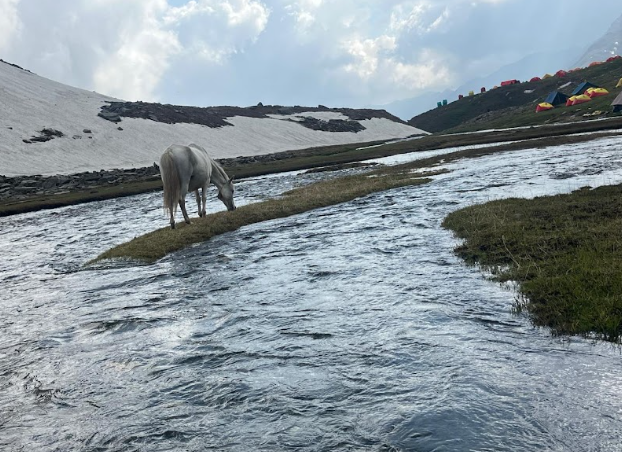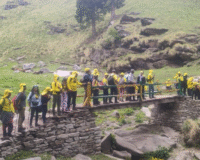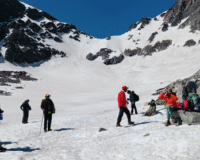Chandranahan Lake Trek: A Hidden Pahadi Gem for True Adventure Seekers
The Indian Himalayas are full of hidden treasures, and the Chandrahan Lake Trek is one of the old adventures that gives raw, untouched beauty. Located in the Pabbar valley in Himachal Pradesh, is a dream for those looking for loneliness, alpine meadows, robust areas and glaciated lakes. Whether you are an experienced trekker or a curious beginner, Chandrahan Lake Trek is a low-lying journey that promises to leave you. Chandranhan’s enchanting setting Chandranhan Lake sits at a height of around 13,900 feet above sea level and is considered sacred by the locals. Surrounded by snow-covered peaks and grasslands, blasted with wild water, the lake is the formation of a glacier melted by melting ice from the surrounding mountains. It remains frozen for most years, to reveal shimmering blue water in the summer. The trip of this lake begins with the jungle, which is a picturesque village that serves as the basis for many trekk in the region. As you move from the jungle to tall camps, you will find yourself crossing dense pine and oak forests, open meadows and rocky terrain. At each stage of the trip, sudden changes in scenes to the attraction, making each step a great experience. A trip through changing landscapes The first stretch from the jungle to Dayara Thach is relatively medium, which gives pull time from time to time in a green environment, and allows time to suck. Dayara Thach is a wonderful meadow prepared by forests and surrounded by peaks – perfect for your first night under the stars. The next few days take you to Litham and finally the crown on the trip to the Chandrahan Lake. One of the most attractive aspects of this journey is the changing geography. From thick forests and slowly walking to high-height grasses, you will cross the glaciers, go with a sharp edge, and finally, near the lake, will almost reach the real surroundings. The advantage of height is important, but the reward is unique beauty. Cultural connection and spiritual enterprise The lake is not just a natural surprise – it has spiritual significance for local communities. The origin of the Pabbar River is believed to be visited by villagers often during the annual pilgrimage. These spiritual initiatives make a team of meaning to the trip, which makes it not only for a physical journey, but also an intimate. Passing through small villages and interacting with local people gives you insight into a Pahdi life style. Warm hospitality, traditional wooden houses and simple mountains provide a cultural recess that increases the drawing experience. Many rural stories, legends and even are happy to share the food, and make you feel at home in these highlands. Best time to visit Chandranhan Lake The ideal time for doing this walk is from May to early July, and then in September to early October. Under these windows the weather is relatively stable, the trails are open and visual crystals are clear. The grasslands bloom perfectly at the beginning of summer, while the fall offers a golden brown palette that fascinates the same. The monsoon months from July to August are the best to survive due to the lack of landslides and smooth trails. Winter makes the area inaccessible due to heavy snowfall. Draw in charge Chandrahan Lake is still away from the beaten track, and it is important to keep it this way by following permanent trekking practice. Take your own water bottles, avoid using plastic, and make sure no waste is left behind. The delicate ecosystem here depends on the sources of snow-filled water and untouched vegetation, which can easily be interrupted by careless tourism. Many local guides and wooden organizers emphasized the importance of leaving the trail as you found. Respect local customs, stick to the designated paths, and support Homestay or environmentally friendly camps whenever possible. Why Chandrahan Lake is worth it Apart from the more popular treks in the Himachal or Uttarakhand, the Chandrahan Lake Trek is characterized by its raw, pristine character. Here is a silence you rarely find on commercial trails. The lake itself feels something out of a Himalaya legend – the icy water reflects the huge mountains around it. Even more compelling is the general mood. It’s not just about reaching the lake, but every forest walk, the air in each mountain and every adaptable smile you get on your way. It’s a trip that links you not only with nature, but also to the deep feeling of being. Final thoughts Chandrahan Lake Trek is a magnificent Himalaya tour waiting to find. With each climb, you leave the noise of the world and enter a country where nature controls the top rule. This is not just a trip – this is a return to the heart of the mountains, where stories of rivers, glaciers and gods live. For those who long for something beyond Instagram trails and busy camps, Chandrahan provides loneliness, peace and spiritual depth.




